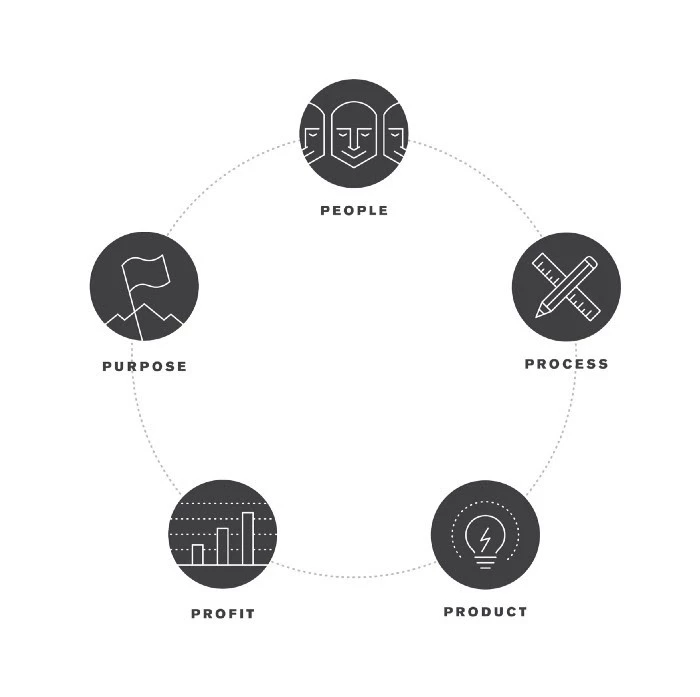As the founder of a design agency with a social mission, I find myself in constant tension. How do we operate as a business (profit) and stay true to our founding mission (purpose)?
These two ideals always seem at odds with each other. And I don’t believe this is a unique problem–when I talk to companies about infusing purpose into their work, this same question frequently comes up.
A few weeks ago, I spoke at an event, and my talk focused on differentiating one’s brand based on an underlying organizational purpose. The first question I received was: “How do I build a purpose-infused business and still make money?” Many of the questions that followed were in the same vein. The people in that session wanted to make a difference with their work, but they also thought that desire was inherently at odds with staying in business.
I believe that profit and purpose can create a real tension that’s difficult to navigate, but only if we accept the assumption that these two things don’t go together.
In a 2015 report on purpose by the Harvard Business Review, Harvard professor Michael Beer claims that “there is an increasing awareness that the purpose of a company has to be beyond shareholder value, and that this is not something that will cost your business but something that will enhance your business.”¹
Procter and Gamble believes that “purpose attracts people” (customers), so much so that in 2007, they conducted a global study of the best brands’ key attributes to test their theory. Here’s line from the report: “Best brands transcend consumer segments and regional markets by rooting their brand in universal values. They create and occupy a mental space that goes beyond the product or the category. They serve a bigger purpose.”²
Most of the time when running a business, we ask ourselves, “What makes the most business sense?” This question automatically creates the false dichotomy of profit or purpose. Instead, at FiveStone we ask, “How can we reflect our purpose in ways that make the most business sense?” This subtle addition to the question removes the dichotomy and allows the two ideals to work in concert with one another, strengthening both. It allows the business to get the things it needs to operate (profit) but doesn’t value them in a disproportionate way.
So what does that look like? How do we operate in both a money-making paradigm and in a purpose-driving paradigm?
The 5 Ps
My friend Steve Graves introduced me to a construct that we use daily at FiveStone that helps manage the tension of purpose and our profits. We call it the 5 Ps: People, Process, Product, Profit, and Purpose.³
Each of these Ps works with the others to create a healthy relationship between the agency’s competing interests. This allows each to have an equal influence over the business and our decision-making process.

People: How can we view our coworkers, teammates, and clients’ teams as partners?
Each member of our internal team works to bring out the best in every other member of the team. This same attitude applies to our clients’ teams, vendors, and contractors.
We strive to see one another as human beings who have lives away from work: meeting with friends and family on the weekends, finishing a degree in the evenings, or caring for their first child. In doing so, we strive for meaningful work relationships that value the other person and places them first.
This perspective shifts the goal of individual performance toward something bigger than any one person, creates a sense of community based on honor and respect.
Process: How can the way we work allow our team to operate in ways they are best wired?
How we work is just as important as what we work on. Without the “how,” an individual or an entire team can quickly slip into second guessing or confusion. And, when this happens we aren’t treating people well.
Processes invite team cohesion: Everyone knows what tools they bring when solving a problem, and then a specific set of actions follow. This creates a kind of settledness within the team because everyone enters the scenario with clear expectations, leading to anticipation rather than apprehension.
However, process does more than create efficiency and clarity in the work. When properly designed, it allows people to work at their best. The process knows when to use who based on their internal wiring, capacity, and other individual considerations.
Product: How can the thing we make reflect “good?”
The product we create is more than a means to an end (profit). Not only does it require thinking about market conditions, supply chain considerations, and quality but also how the product reflects our purpose. The product we make should reflect “good.”
At FiveStone, we define a good product in three ways:
Beautiful: Does the work call people to look past itself to something transcendent?
Beneficial: Have we contributed something meaningful to the world?
Lasting: Does the work impact people at their core, changing the way they see the world?
When the product is reduced to something that you sell or that you know others will buy, then a primary expression of your purpose becomes tarnished. We must force ourselves to think of the product as more than mere objects or outcomes.
Profit: How can we reflect purpose in ways that make the most business sense?
In addition to all the good we’re trying to do, we are bound by the rules that govern business. Simply stated, that means in order for us to stay open, we have to make money.
The difference for FiveStone is that we try to shift our view of money. We don’t want to extract as much as we can from people in order to make a lot of money for a only a few. Instead, we want to think about money as a way to create communities of wealth that lift up all people not only through financial gain but through spiritual and relational gain as well.
The difference in this mindset isn’t to relegate profit as some sort of evil by-product of work but instead to properly contextualize it. In other words, profit cannot come at the expense of the other four Ps.
Purpose: How can we use our skills and talents to lovingly respond to the needs of the world?
At FiveStone, we view our work as more than just a paycheck or avenue for personal satisfaction. Instead, we believe that our work matters. What we make matters. How we work, and for whom we work, matters. In this context, we see that our work is not only something we do to earn a living. It is not just a means to an end or a way to fund vacations and brunches. It can be much more.
We see our work as one of the primary ways in which we can take responsibility for the world. So, as we work, we are using our time, talents, and energy to respond to the needs of the world and, in our own way, bring healing. In this, we find individual and collective purpose.And it comes, in part, when we roll up our sleeves and do something good.
There’s no right answer but instead a right intent. This intent pushes your business to constantly evaluate the why, who, what, and how of your work.
All of the 5 Ps work together for complete success. As an example, if we make a great product and lots of money but treat people poorly along the way, then that is not a win for us. The opposite is also true. If we treat people well and make a good product with a great process but didn’t make enough money to stay in business, then that’s no good, either. The tension of all 5 Ps creates the space to properly view each of the individual components. No one P should outweigh the others.
As you wrestle with the question of profit and purpose within your business, I hope this framework can help. But keep in mind: There’s no right answer but instead a right intent. This intent pushes your business to constantly evaluate the why, who, what, and how of your work. In the end, your profit and your purpose can work together to create a lasting and meaningful brand.
This is an excerpt from CULTURE BENDING NARRATIVES: Moving Beyond Story to Create Meaningful Brands.
1. The Business Case for Purpose — A Harvard Business Review Analytic Services Report, Harvard Business Review Analytic Services and EY, 2015.
2. The Story of Purpose: The Path to Creating a Brighter Brand, a Greater Company, and a Lasting Legacy, Joey Reiman page 23.
3. I don’t believe the 5P framework to be unique to FiveStone. However, we have personalized it and built on it. The 5P framework was introduced to me by Steve Graves.
The FiveStone team is now part of Whiteboard.
Since 2001, we have worked with some of the most courageous organizations on the planet. We've walked alongside these organizations by offering strategy, branding, and campaigns to bring about positive change in the world.
As we think about how we might continue to live out our mission—“amplifying positive impact”—over the years ahead, we are excited to announce that we are joining forces with Whiteboard.
Whiteboard is an award-winning creative agency and Certified B-Corp. Like FiveStone, they believe in the power of Design to make the world a better place. It is clear to us that by bringing together the power of our strategic focus with their strong digital offering, we can truly build—as Whiteboard says—”the world that ought to be.”
We are thrilled to join Whiteboard and cannot wait to bring Whiteboard’s full suite of services and offerings to all our partners.
See more about Whiteboard here or visit the archived FiveStone site here.
